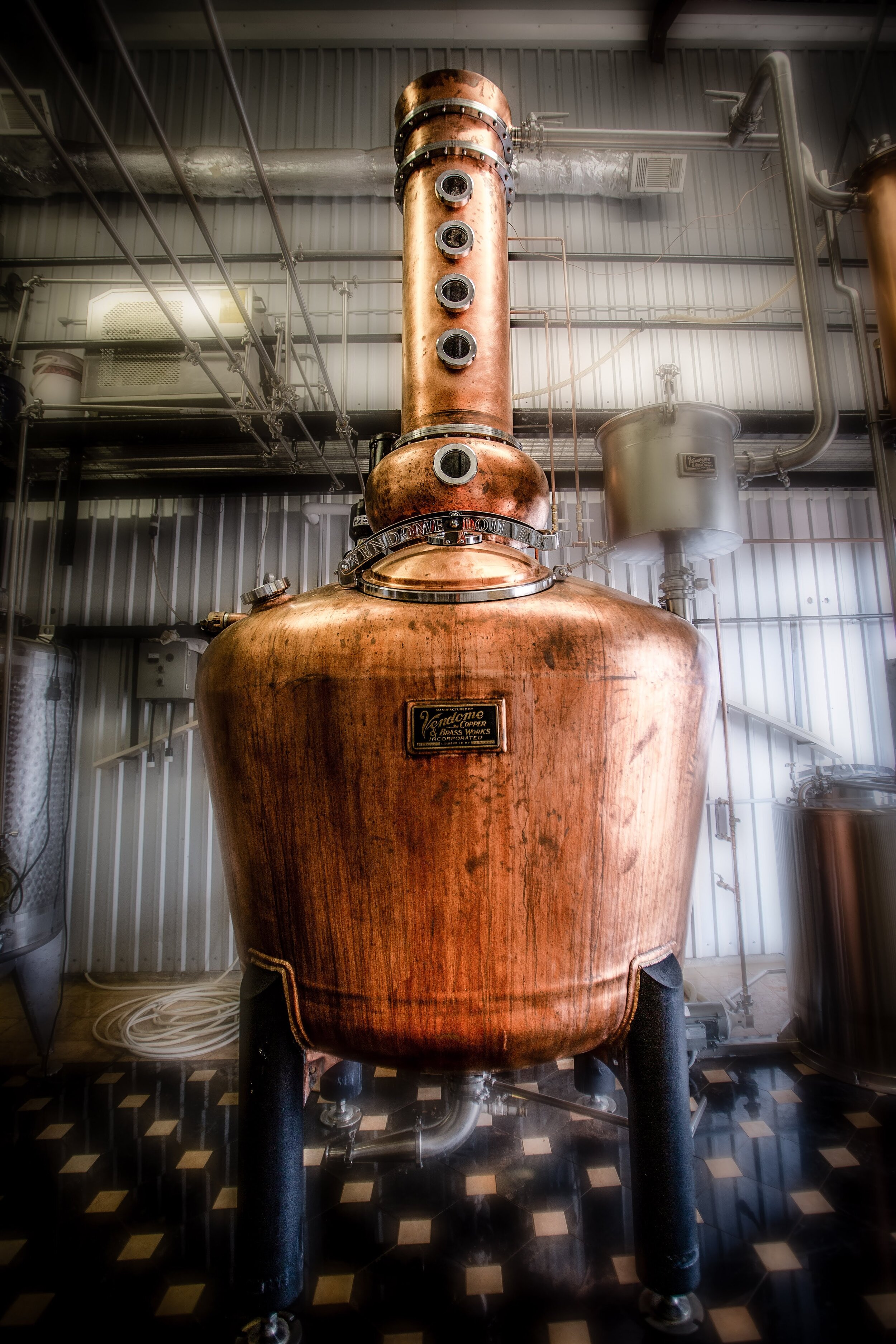The Distillation Journey: Part Three
Welcome to the final part of our bourbon-making series. After mashing and fermentation, the distiller's beer is ready for distillation, a critical process in crafting whiskey's unique flavors and characteristics. Distillation not only separates alcohol from the fermented mash but also refines and purifies the spirit, enhancing its complexity and depth. There are two main types of stills used in this process: pot stills and column stills. Let's explore how each of these stills contributes to the art of distillation and examine the pros and cons of each method.
Pot Stills
A cornerstone of traditional whiskey-making, pot stills resemble large kettles with a spherical main chamber, a swan neck, and a Lyne arm extending to a condenser. This classic design has been used for centuries and remains a favorite among many distillers for its ability to create rich, full-bodied spirits.
The Distillation Process in Pot Stills
The wash, or fermented mash, is heated in the main chamber until the ethanol begins to vaporize. The ethanol vapor rises to the head of the still, exiting through the swan neck and the Lyne arm into the cooling coil, where it condenses back into liquid form. This liquid is collected as the distillate.
Key Features of Pot Stills:
Main Chamber or Pot: This allows for heating and efficient vaporization of alcohol. The size and shape of the pot can influence the flavor profile of the spirit, with larger pots often producing smoother, more complex flavors.
Swan Neck and Lyne Arm: These components direct the alcohol vapor towards the condenser. The angle and length of the Lyne arm can also impact the spirit's character, with higher angles often resulting in lighter, more delicate flavors.
Condenser: Typically, a coiled tube immersed in water, the condenser cools the vapor back into liquid form. The type of condenser can affect the efficiency and style of distillation.
Modern pot stills often use temperature-controlled steam for heating, though some distillers still prefer direct heat for its traditional influence on flavor. Direct heat can produce subtle caramelization of the wash, adding complexity to the final product.
Pros and Cons of Pot Stills
Pros:
Flavor Complexity: Pot stills are renowned for producing spirits with rich, complex flavors. The batch process allows for greater control over the flavor profile.
Traditional Character: The use of pot stills is steeped in tradition, appealing to enthusiasts who appreciate the historical aspects of whiskey-making.
Craftsmanship: The slower, hands-on process allows for artisanal touches, resulting in unique and high-quality spirits.
Cons:
Efficiency: Pot stills are less efficient than column stills, requiring more time and energy to produce the same amount of spirit.
Batch Process: The batch nature of pot distillation can limit production capacity, making it less suitable for large-scale operations.
Column Stills
Column stills, also known as continuous stills, are taller and more industrial-looking than their pot still counterparts. These stills consist of multiple chambers stacked vertically, allowing for a more efficient and continuous distillation process.
The Distillation Process in Column Stills
The wash is introduced at the top of the column and descends through the chambers. Meanwhile, steam is introduced at the bottom, causing the ethanol to vaporize and rise through the chambers. As the ethanol vapor ascends, it condenses and re-evaporates at each stage, progressively purifying the spirit. The purified ethanol exits at the top of the still in a very pure form.
Key Features of Column Stills:
Multiple Chambers: Each chamber functions as a mini-distillation, facilitating continuous distillation and purification. This design allows for a higher degree of control over the distillation process.
Vertical Setup: The tall, vertical design enhances efficiency and allows for higher throughput. This setup enables the production of large quantities of spirit without sacrificing quality.
Purification Process: The repeated condensation and re-evaporation ensure high purity, resulting in a cleaner, more refined spirit. This process can be adjusted to create different flavor profiles, from light and floral to rich and robust.
Pros and Cons of Column Stills
Pros:
Efficiency: Column stills can operate continuously, making them more efficient and capable of producing large quantities of spirit.
Consistency: The continuous process ensures a consistent product, with less variation between batches.
Purity: The multiple stages of distillation result in a highly purified spirit, which can be desirable for certain styles of whiskey and other spirits.
Cons:
Flavor Profile: The high level of purification can strip away some of the congeners that contribute to the complexity and character of the spirit, resulting in a lighter flavor profile.
Industrial Appearance: The more industrial design of column stills may lack the romantic appeal of traditional pot stills for some enthusiasts.
Initial Cost: The setup and maintenance of column stills can be more expensive, requiring significant investment in equipment.
Understanding the mashing, fermentation, and distillation processes provides a comprehensive view of how whiskey is crafted. Each step is vital in creating the unique flavors and characteristics of the final product, whether it's a bourbon or a Scotch. By mastering these processes, distillers can produce spirits with distinct profiles that delight whiskey enthusiasts around the world.
Thank you for joining us on this journey through the heart of bourbon-making. We hope you’ve gained a deeper appreciation for the craft and complexity involved in producing your favorite whiskey. So, pour yourself a glass of Jimmy’s Blended Bourbon and toast to the art of distillation. Cheers!
Dylan Latham is Kiepersol’s Distiller. Creating enticing spirits from scratch ignited his passion for the craft of distilling. He fits right in at a distillery that values faith, family, and a genuine love of people. With a focus on craftsmanship and a dedication to creating exceptional beverages, he brings joy to others through his creations.
Dylan is a native Texan, a former financial professional, and an avid bourbon collector.


